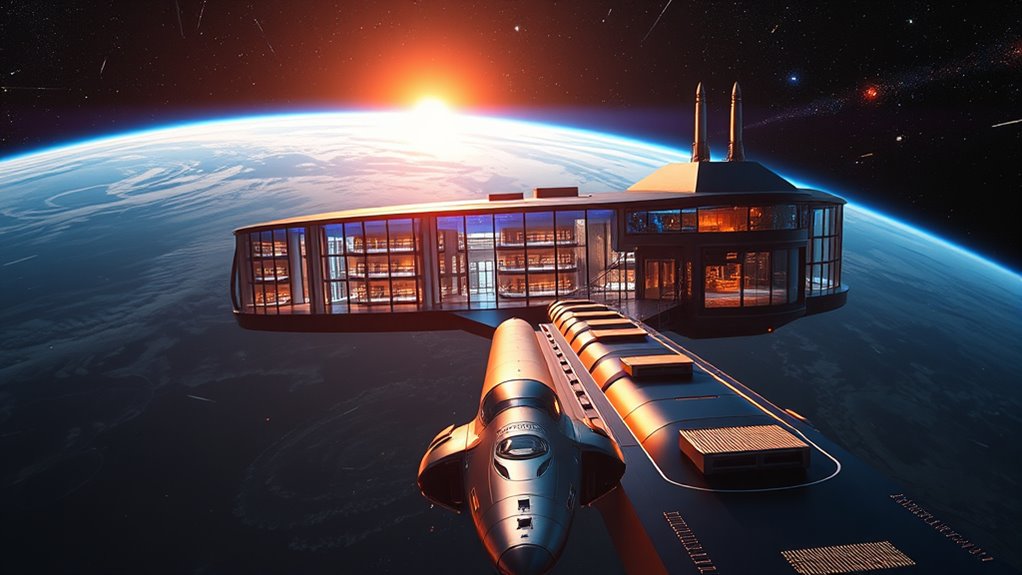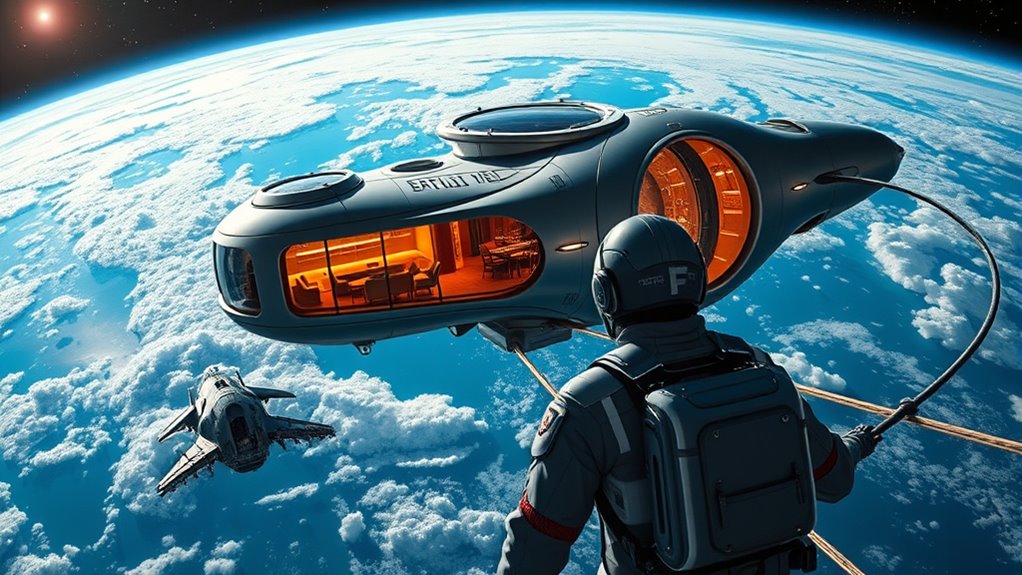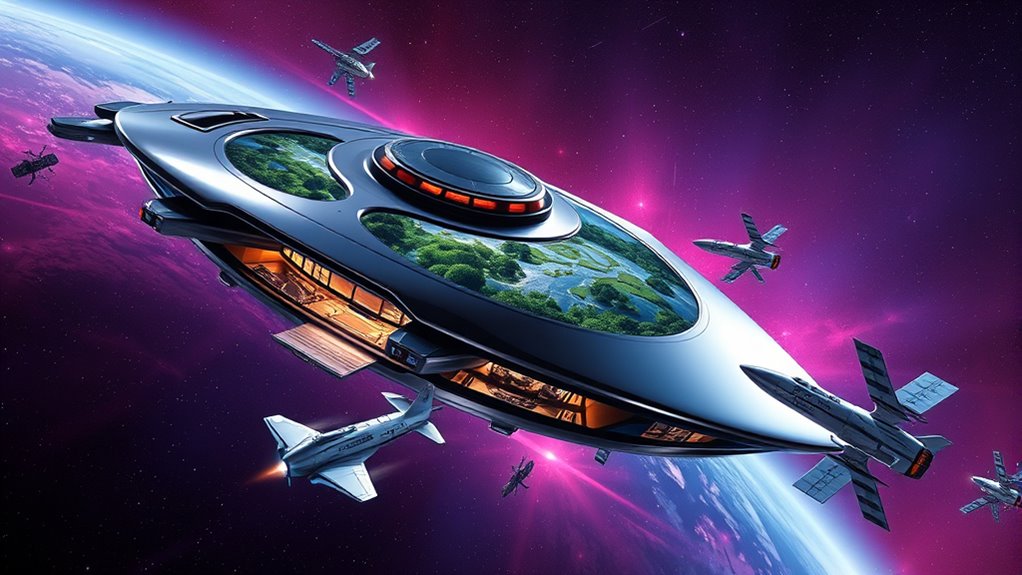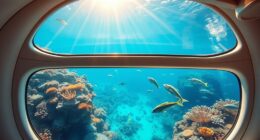Space hotels are set to revolutionize luxury travel by offering incredible orbital experiences that blend comfort with scientific innovation. Imagine staying in rotating habitats with artificial gravity, panoramic views, and high-end amenities designed for ultimate relaxation. These futuristic hotels will cater to wealthy adventure seekers and researchers alike, combining cutting-edge engineering with luxurious interiors. As this exciting industry develops, you’ll discover how advancements in design, safety, and opportunity are making space tourism a reachable reality.
Key Takeaways
- Space hotels combine sci-fi design with advanced engineering to create luxurious orbital habitats for space tourism.
- Artificial gravity is generated through rotation, providing familiar environments for guests in microgravity.
- Amenities include panoramic views, zero-gravity sports, themed restaurants, and customizable interior spaces.
- Industry leaders are developing modular, durable habitats like Voyager and Pioneer to attract high-net-worth travelers.
- The sector faces challenges in safety, legal regulations, and sustainable operations, but offers significant growth and research opportunities.
The Vision Behind Space Hotels

The vision behind space hotels combines inspiration from classic science fiction with practical engineering to create a new frontier in luxury tourism. You’re looking at a space habitat designed as an orbital resort, blending familiar comforts with the extraordinary environment of space. This concept takes cues from movies like *2001: A Space Odyssey* and *Interstellar*, shaping both form and function. The goal is to make orbital living feel natural and inviting, with artificial gravity generated by rotating structures based on aerospace principles. Unlike traditional space stations, these hotels aim to offer immersive resort experiences, where guests can enjoy dining, sleeping, and leisure activities in a comfortable, gravity-simulated setting. This vision transforms space travel into accessible, high-end hospitality, opening a new chapter for luxury tourism beyond Earth. Artificial gravity created through centrifugal force will enable guests to move freely and perform routine activities just as they would on Earth. Additionally, advances in space habitat design are crucial to ensuring safety and comfort for future space travelers.
Pioneering Projects: Voyager and Pioneer Stations

You’ll see how Voyager and Pioneer stations are shaping the future of space hospitality with their ambitious construction timelines and innovative designs. These projects feature large, rotating structures that create artificial gravity and offer luxurious amenities for guests. Their development marks a significant step toward making space tourism a routine and comfortable experience. Incorporating advanced structure stability techniques ensures the safety and durability of these rotating habitats in the harsh environment of space.
Construction Timelines and Launches
Construction of the Pioneer and Voyager stations is progressing rapidly, with plans to accelerate beyond traditional space project timelines. You’ll see Pioneer’s components launching around 2025, aiming for operational status that year, while Voyager’s construction begins around 2026 for a 2027 opening. The Orbital Assembly Corporation leads these efforts, focusing on quick assembly using modular parts and reusable launch vehicles like SpaceX Falcon 9 and Starship. 1. Pioneer’s launch schedule aligns with space law requirements and environmental impact assessments to ensure regulatory compliance. 2. Voyager’s construction timeline is designed to be just 1–2 years, considerably faster than the ISS’s decade-long build. 3. Rapid assembly in low Earth orbit minimizes environmental concerns and speeds deployment. 4. These accelerated timelines aim to set new standards for space construction, balancing innovation with regulatory and environmental considerations. The project has secured funding and official approval, demonstrating growing confidence in the venture’s viability. Additionally, advances in modular construction techniques are contributing to the efficiency of assembly processes.
Design and Structural Features
Voyager and Pioneer stations showcase innovative structural designs tailored for their unique purposes in space. Voyager features a massive, 488-meter circular ring that revolves to generate artificial gravity through centrifugal force, supported by modular construction of 24 living and activity modules linked via pressurized transfer shafts. Its design emphasizes leisure with facilities like observation decks, entertainment venues, and commercial spaces, all powered by advanced space station power systems. The stations employ float mounting textile art techniques to ensure stability and ease of assembly in the zero-gravity environment. Pioneer Station adopts a different approach, with a rotating “Gravity Ring” architecture and customizable modules that accommodate various gravity levels, enhancing comfort and versatility. Both stations exemplify cutting-edge modular construction techniques, integrating power supply systems suited for long-term operations in space. Their structural features prioritize stability, adaptability, and efficient use of space, setting new standards for space hotel design.
Guest Experience and Amenities
The innovative structural designs of Voyager and Pioneer stations directly influence the guest experience and amenities they offer. You’ll enjoy artificial gravity through centrifugal force, making daily activities feel familiar and comfortable. Both stations feature advanced recreational options, with Voyager boasting luxury amenities like themed restaurants, bars with panoramic Earth views, and zero-gravity sports. Pioneer offers more functional spaces, including opportunities for space farming and underwater habitats, supporting research and relaxation. Moreover, the choice of materials and construction techniques ensures durability and safety in the harsh space environment, aligning with best practices in space station design.
Navigating the Space Hotel Location and Travel Logistics

Managing the location and travel logistics of space hotels involves understanding their orbital positions, transportation methods, and safety considerations. Orbital locations, like Aurora Station at 200 miles and Voyager Station in low Earth orbit, influence travel ease, safety, and environmental impact—since lower altitudes increase radiation exposure, requiring robust safety measures. Traveling involves reusable rockets and spacecraft, with trips lasting under an hour once launched. You’ll need extensive pre-flight training, such as the Orion Span certification, to prepare for microgravity and safety protocols. International regulations governing orbital use are evolving to address the complexities of space tourism, requiring compliance for operators and travelers alike. Geopolitical implications arise from international cooperation and regulations governing orbital use. Limited capacity and strict scheduling demand precise planning, while ongoing technological advances aim to reduce costs and environmental footprint. Ensuring stability and safety in this remote environment remains a critical challenge for future space hospitality. Additionally, the orbital environment’s proximity to Earth affects communication latency and logistical support, which must be carefully managed for a seamless guest experience.
Engineering Marvels: Creating Artificial Gravity in Orbit

Creating artificial gravity in space hotels relies on precise rotation mechanics and speed to mimic Earth’s pull without causing discomfort. Structural design must handle rotational stresses and thermal shifts while keeping the station airtight and safe. Balancing gravity levels and changeover zones presents engineering challenges that require innovative solutions to guarantee comfort and safety for guests. Advances in materials science are essential to ensure the station’s structure can withstand the complex stresses of rotation and thermal fluctuations over time. Incorporating rotational engineering principles is crucial for optimizing stability and minimizing vibrations that could affect guest comfort.
Rotation Mechanics and Speed
Achieving comfortable artificial gravity in space habitats hinges on understanding rotation mechanics, where the habitat spins to generate a centripetal force that mimics Earth’s gravity. The key factors are the radius and angular velocity ((omega)), which determine the acceleration felt by occupants.
- Larger radii allow lower angular velocities, reducing motion sickness and Coriolis effects.
- Typically, habitats aim for 0.5–1 rpm to balance comfort and rotation stability.
- Higher rotation speeds increase centrifugal force but can cause disorientation.
- Maintaining steady rotation requires precise control of angular velocity and mass distribution to prevent wobble and resonance.
- The design of the habitat’s interior also plays a crucial role in minimizing adverse effects associated with rotation, ensuring a more comfortable environment for inhabitants.
Optimizing these parameters ensures a stable, comfortable environment that simulates gravity effectively while minimizing physiological disturbances.
Structural Design Challenges
Designing space habitats to generate artificial gravity presents unique structural challenges that demand innovative engineering solutions. Your focus must be on habitat durability, ensuring the structure withstands space’s harsh environment. Material innovation is vital; advanced composites and alloys provide lightweight yet resilient options that resist temperature extremes and micro-meteoroid impacts. Modular construction allows for efficient assembly in orbit, but each module needs to seamlessly integrate while maintaining structural integrity. Engineers must optimize the design to handle the centrifugal forces generated by rotation, preventing deformation or failure. Safety and durability hinge on selecting the right materials and engineering methods. Additionally, understanding space environment effects is essential for ensuring long-term habitat stability. Ultimately, overcoming these challenges guarantees a stable, long-lasting habitat capable of supporting luxurious space living for years to come.
Gravity Simulation Variability
Artificial gravity in space hotels is primarily generated through rotation, using centrifugal force to push occupants outward and simulate gravity. To guarantee guest comfort and health, gravity variability is carefully managed by adjusting rotation speed or habitat radius. This approach allows for multiple gravity levels, from lunar-like (~0.16g) to Mars-like (~0.4g), supporting different activities and medical needs. Additionally, the design must account for potential gravity fluctuations caused by changes in rotation speed or orbital perturbations, which can affect comfort. Rotational stability is maintained through gyroscopic stabilization and dynamic mass distribution, preventing wobbling. Minimizing Coriolis effects by keeping rotation speeds below 2 rpm helps avoid dizziness. Modular zones with varied gravity levels offer tailored experiences and facilitate research on human adaptation to different gravity environments.
Designing Luxurious Interiors for Outer Space Guests

Creating luxurious interiors for space hotel guests involves blending comfort, aesthetics, and functionality in a challenging environment. You’ll select durable, visually appealing materials that withstand space conditions while offering elegance. Panoramic windows provide breathtaking views of Earth and space, enhancing the experience. Lighting systems mimic natural circadian rhythms, supporting your well-being in a setting without day-night cycles. You’ll incorporate space cuisine that’s both delicious and designed for zero gravity, ensuring meals are enjoyable despite microgravity. Zero gravity fashion becomes part of the environment, with stylish, functional clothing adapted for comfort and practicality. Modular furniture transforms to maximize utility in compact quarters, and customizable ambiance allows you to tailor lighting and decor to your preferences. Selecting the right furnishing materials is crucial for durability and style, ensuring the environment remains luxurious and functional. Every detail aims to create a luxurious, immersive experience beyond Earth’s bounds.
The Competitive Landscape of Space-Based Hospitality

As the space-based hospitality industry rapidly expands, competition among key players intensifies, shaping the future of commercial space lodging. You’ll see companies like Orbital Assembly, Axiom Space, and Blue Origin racing to develop space stations and habitats.
- They’re steering through complex space law to establish operational rights and safety standards.
- Heavy investments in astronaut training ensure crews meet rigorous safety and hospitality requirements.
- North America leads due to technological innovation hubs and funding, with Europe and Asia-Pacific quickly catching up.
- Early entrants target high-net-worth individuals and corporate clients, leveraging unique experiences and advanced AI for operational efficiency.
- The development of specialized space habitats with innovative design features is also a key factor in attracting discerning clientele.
These dynamics create a fiercely competitive landscape where innovation, regulation, and strategic partnerships determine who dominates the next frontier of luxury space lodging.
Scientific and Commercial Opportunities in Space Hotels

Space hotels open up exciting scientific and commercial opportunities that extend beyond hospitality alone. They serve as platforms for advanced research in biology, physics, and materials science, utilizing microgravity environments. This accelerates discoveries in space agriculture, helping develop sustainable food production systems for long-term space missions. Additionally, space hotels can support extraterrestrial mining efforts by testing resource extraction technologies in orbit, paving the way for future resource utilization on the Moon or asteroids. These activities not only benefit space exploration but can also lead to innovations in environmental management and sustainability on Earth. With collaboration between scientists and hospitality experts, space hotels become hubs for technological breakthroughs, infrastructure development, and commercial ventures that push the boundaries of what’s possible in space and on our planet. Diverse research opportunities offered by microgravity environments further enhance the potential for groundbreaking innovations in various scientific fields.
Challenges and Future Prospects for Space Tourism

Despite the exciting potential of space tourism, it faces significant technological and safety hurdles that must be overcome before it becomes mainstream. You’ll need reliable reusable rockets and advanced safety protocols to guarantee passenger well-being. Addressing cosmic radiation exposure requires better shielding, especially for longer stays. Improving spacecraft comfort and reducing motion sickness are vital for passenger experience. Additionally, safety standards and international space law must evolve to protect tourists and the environment. Incorporating geometric principles into spacecraft design could improve structural integrity and efficiency, further supporting safe space travel. Balancing innovation with environmental stewardship and regulatory harmonization is key to opening future space tourism prospects.
Frequently Asked Questions
How Safe Are Space Hotels for Extended Human Stays?
You might wonder how safe space hotels are for extended stays. They’re designed with robust shielding against space debris and incorporate emergency protocols for sudden events like solar flares. The habitat’s structure is built to withstand impacts, and quick evacuation measures are in place. Combined with continuous health monitoring and radiation protection, these features make long-term habitation safer, though risks remain, requiring ongoing improvements and vigilance.
What Are the Costs Associated With Booking a Space Hotel Room?
Imagine gazing down at Earth from orbit—exciting, right? The cost estimation for booking a space hotel varies widely. Orion Span’s Aurora Station charges around $9.5 million, requiring an $80,000 refundable deposit, with booking done online. Voyager Station’s prices are still unconfirmed but expected to be steep. Booking procedures typically involve deposits, reservations, and selecting stay durations, making space tourism a luxurious yet costly adventure you’ll want to plan carefully for.
How Will Space Hotels Be Regulated and Insured Legally?
You’ll find that legal frameworks for space hotels involve international treaties like the Outer Space Treaty, along with updated U.S. regulations from agencies like the FAA. Insurance policies will be tailored to cover space-specific risks like debris collisions and microgravity effects. You can expect strict safety standards and liability clauses, with insurers and governments collaborating to develop risk-sharing models, ensuring your safety and compliance in this emerging, regulated industry.
What Technologies Ensure Life Support and Sustainability in Space Habitats?
Imagine you’re in a sci-fi novel—advanced tech keeps you alive. You rely on closed loop life support systems that recycle air, water, and waste, ensuring sustainability. Renewable energy systems power these habitats, reducing dependence on Earth. Air revitalization, water purification, and waste recycling work seamlessly to maintain a safe environment. These technologies create a self-sufficient habitat, crucial for long-term space living and pioneering the future of off-world settlements.
When Will Commercial Space Hotels Become Accessible to the General Public?
You’re wondering when space tourism will open orbital accommodations to everyone. Currently, commercial space hotels target ultra-wealthy clients, with widespread access expected after 2030. As launch costs decrease and technology advances, more people will experience orbital accommodations. Regulatory frameworks, safety standards, and infrastructure must mature first. So, while the dream of accessible space hotels may become reality in the next decade, full public access hinges on technological, economic, and legal progress.
Conclusion
As you imagine the future of space hotels, it feels like a natural evolution—just as technology advanced, so did our desire to explore beyond. With pioneering projects leading the way and luxury interiors shaping new horizons, it’s clear that space tourism isn’t just a dream but a reality waiting to unfold. Coincidence or not, the next frontier of luxury lodging is closer than you think, blending innovation with adventure in perfect harmony.








